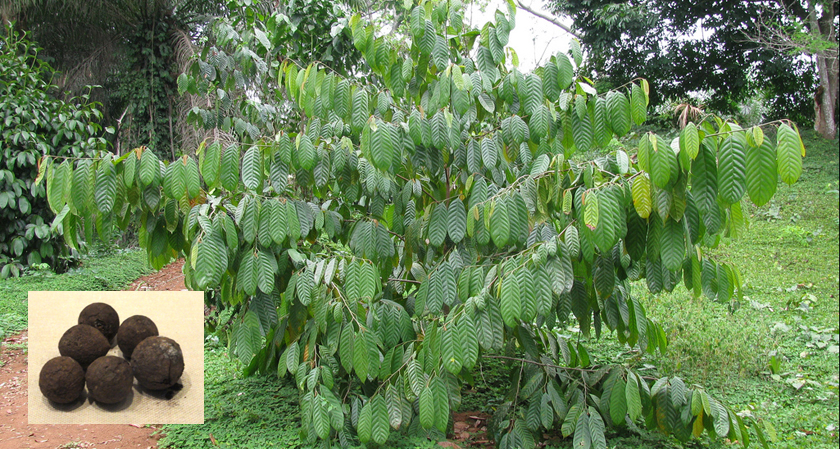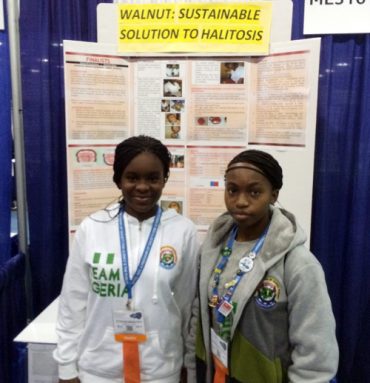Solving bad breath one walnut at a time

African walnut trees, Coula edulis, are common in Nigeria. The nuts (inset) taste good and, as two teens found, might prevent bad breath.
Tree: Scamperdale/Flickr (CC BY-NC 2.0); inset: Daderot/Wikimedia Commons
LOS ANGELES – We’ve all woken in the morning with that classic “morning breath.” Bacteria that live in your mouth cause this bad breath, or halitosis. The microbes feast upon little bits of food left behind by the last meal. Their wastes include stinky chemicals such as hydrogen sulfide and methyl mercaptan. Many people with halitosis are nervous about their breath, and use mouthwashes or chewing gum to mask the smell. But two students from Nigeria have found a solution that is a little more local: the African walnut tree.
Eveshorhema Samuel-Alli, 14, and Ibukunoluwa Oladeinde, 16, showed that African walnuts not only help prevent bad breath, but also kill the bacteria that produce it. Their finding could provide a cheap solution to a bad breath for people in Nigeria and other countries where the African walnut tree grows.
Both teen scientists are juniors at Doregos Private Academy in Lagos, Nigeria. They presented their findings here, this week, at the Intel International Science and Engineering Fair. Created in 1950 by the Society for Science & the Public, and sponsored by Intel, this competition brings together high school students from around the world to show off their scientific discoveries. (SSP also publishes Science News for Students and this blog.)
Eveshorhema first noticed the walnut effect while on a school trip to a rural area in Nigeria. The host village served these nuts to the students. The African walnut, Coula edulis, is not related to the walnuts snacked on by people in Europe and the United States. The African walnut grows in tropical Africa, including countries such as Nigeria and the Democratic Republic of Congo. It produces edible nuts that taste a bit like hazelnuts. They are tasty. But as Eveshorhema found, they offer another benefit as well.

To test this, Eveshorhema and Ibukunoluwa made up two different walnut products. After chopping the walnuts in a blender or pounding them, the teens mixed some with resin and sugar to make a gum. They mixed another batch of walnuts with lime and water to make a mouthwash. Then they took 35 volunteers and divided them into four groups. One group ate whole walnuts. Another group chewed walnut gum. The third used walnut mouthwash. The remaining volunteers did none of those things. That made them “controls,” an unaffected group against which they could compare test conditions.
The teens had to check the participants breath, but luckily, no one had to smell anything. Instead, Eveshorhema and Ibukunoluwa had their volunteers blow bubbles into a solution of lead nitrate and water. When hydrogen sulfide is present, the lead nitrate turns black.
Control participants had bacteria in their mouths. So when they blew bubbles, the water turned black. But the solution remained clear when the test volunteers from the three walnut groups blew bubbles into it.
The teen researchers hypothesized that the walnut was killing some mouth bacteria. So they swabbed the mouths of each volunteers. Then they grew the bacteria that had been present and counted them. Sure enough, participants eating walnuts had fewer bacterial guests.
Eveshorhema and Ibukunoluwa suspect that chemicals in African walnuts — such as oleic acid, alkaloids and tannins — might be killing off the stinky germs. But to confirm that, someone will have to conduct more tests.
In Nigeria, Ibukunoluwa says, “People spend a lot of money importing mouthwash, mouth sprays and gums.” But those only temporarily mask bad breath, she notes. If walnuts can kill the bacteria behind bad breath, treating halitosis could become “easier, cheaper and local.” The teens’ findings might save people money and spare them the embarrassment of bad breath.
Follow Eureka! Lab on Twitter
Power Words
African walnut (Coula edulis) A tree found in Africa countries, including Nigeria and Angola. The tree is not related to the walnut species known in Europe and the United States. It has edible nuts and its wood is very useful in building.
alkaloid A type of naturally occurring chemical with many nitrogen atoms in the structure. Alkaloids are often produced by plants, and they can have many effects on the body and brain. Examples include drugs such as cocaine and morphine.
fatty acid Large molecules made of up chains of carbon and hydrogen atoms linked together.
halitosis Bad breath.
hydrogen sulfide A chemical compound that has a sulfur atom bonded to two hydrogen atoms (H2S). It is a colorless gas that is often produced when bacteria are active without the presence of oxygen. Hydrogen sulfide is the smell that most people associate with swamps or rotten eggs.
lead nitrate A compound containing lead, nitrogen and oxygen. It was once used in lead paint and now is used in industrial applications.
methyl mercaptan Also known as methanethiol, methyl mercaptan is a naturally occurring chemical produced by bacteria. It is one of the main compounds in bad breath.
oleic acid A naturally occurring fatty acid that is found in animal and vegetable fats including nuts.
tannin A reddish and bitter plant chemical that can serve as a natural pesticide. People have also used these chemicals to tan leather.